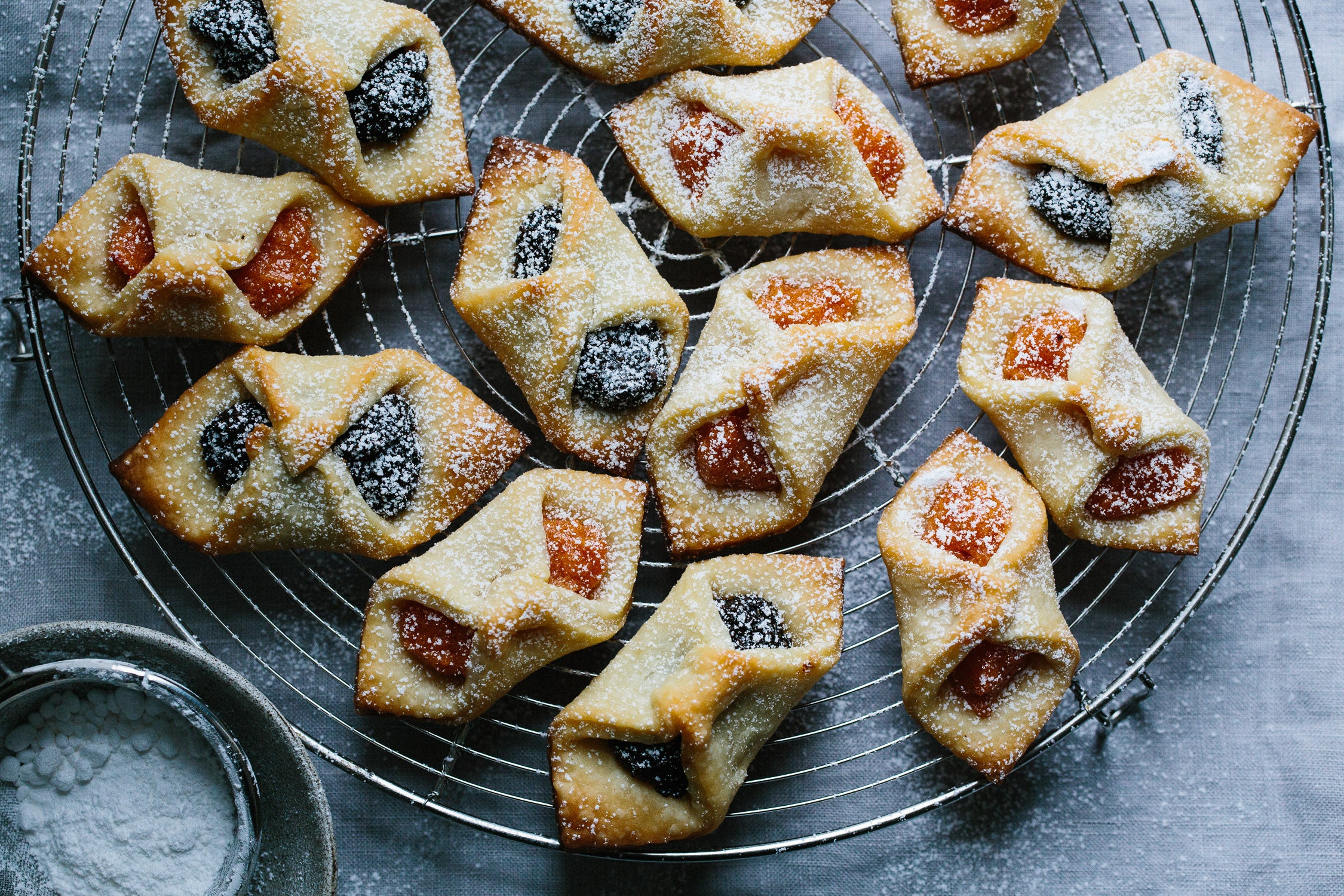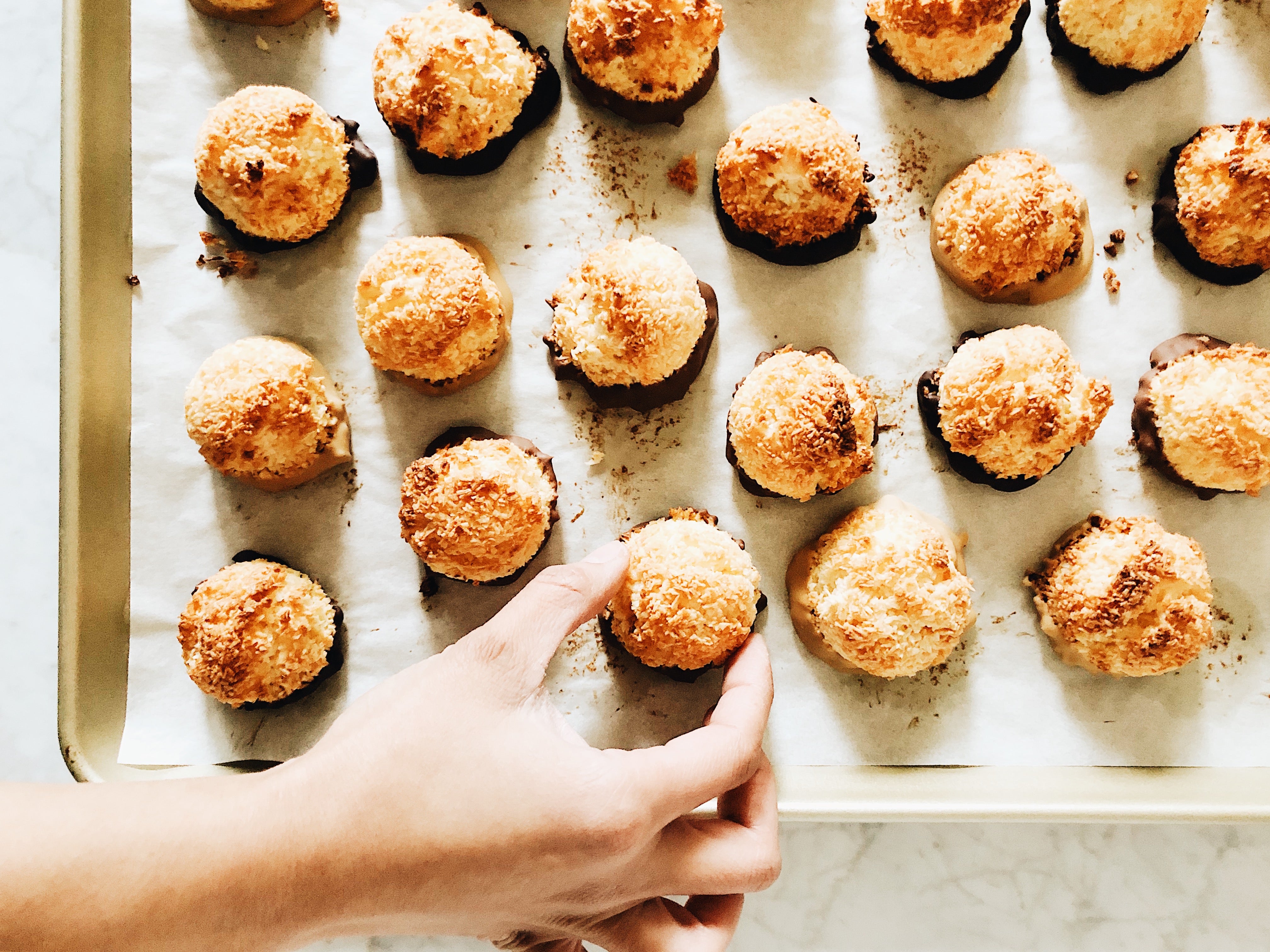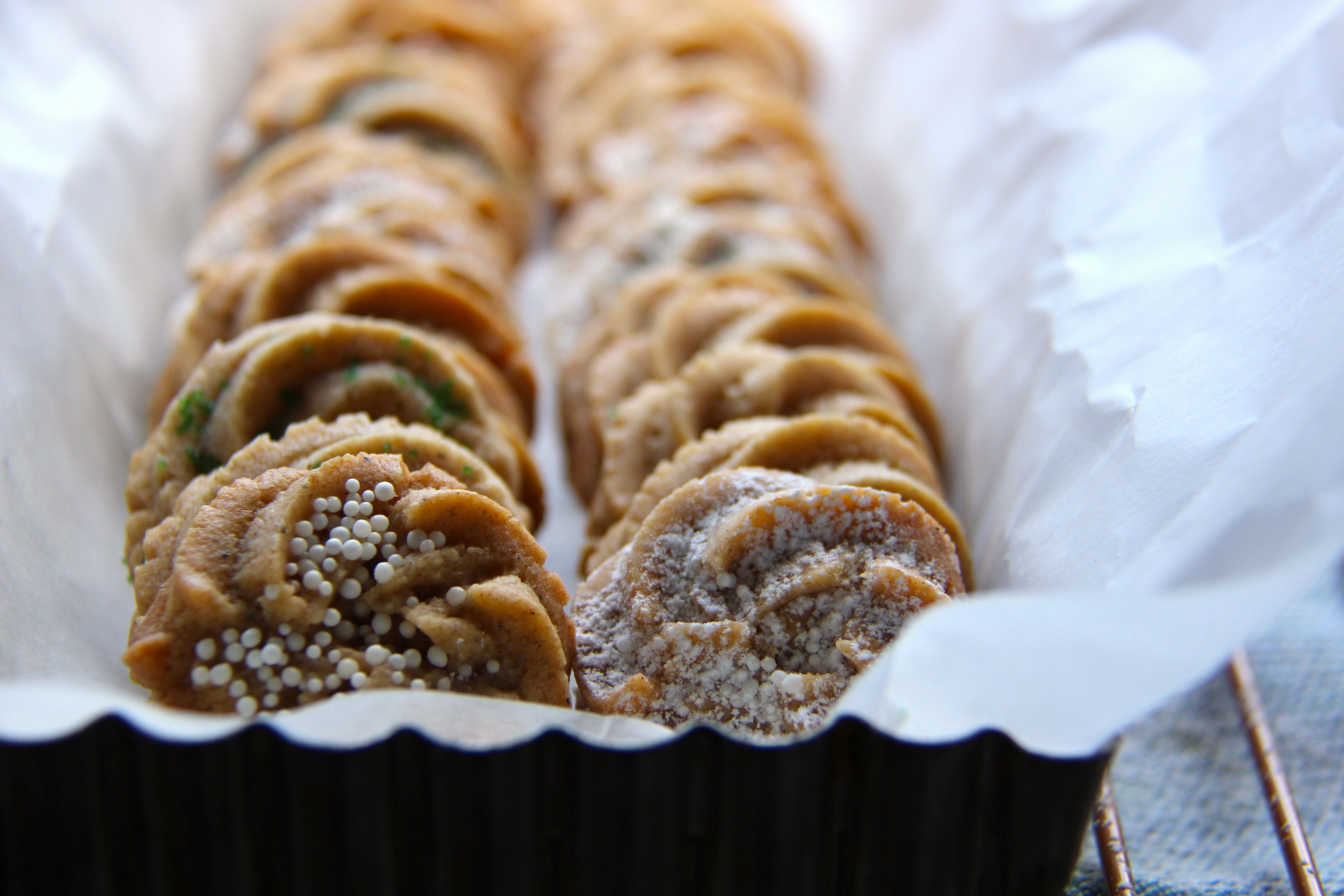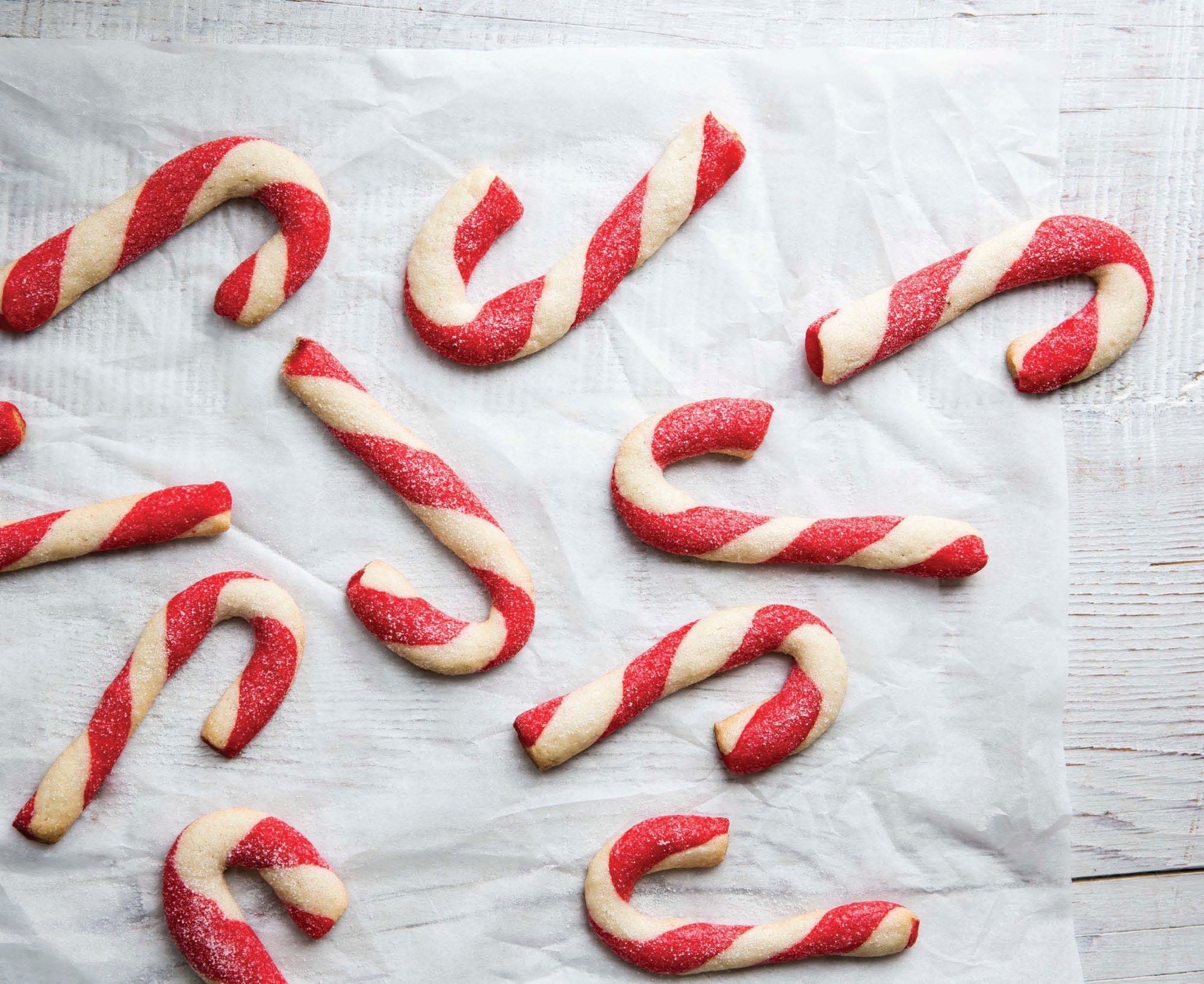Four writers on the holiday cookies that will be getting them through the season.
We make holiday cookies to exchange with friends and eat after convivial family meals, but half of the draw is the comforting ritual of the making itself—the rolling up of the sleeves, the crisp cut of a well-floured cookie cutter, and the snow-like dusting of confectioners’ sugar. Baking cookies is a type of work that roots you in the season, overtaking your senses with the smells and textures and motifs of Christmas.
For Elisabet der Nederlanden, the author of Holiday Cookies, the ritual is rooted in Sweden, where she grew up in the country, working as a teenager in a local bakery. Her new book celebrates some of the mainstays of Swedish Christmases—the cinnamon- and cardamom-laced cookies and the gingery, crisp pepparkakor—as well as Italian pignoli, French pain d’epices, Austrian linzer augen, and South American alfajores.
As precise and detailed and faithful to tradition as these recipes and techniques are, they are also deeply personalizable. Among the repetitive, mechanical motions of cookie-making, there are an infinite number of small gestures that will set your cookies apart from the cookies that everybody else you know will make. This is why we asked four different writers and home bakers to pick a recipe from the book and put their own spin on it. Maybe you, like Molly Yeh, will outfit your gingerbread people in cozy holiday sweaters, or maybe, like Michelle Lopez, you’ll dip your coconut macaroons in an ombré of different chocolates. The recipes are just the starting points.

MOLLY YEH, blogger at My Name is Yeh and author of Molly on the Range
Ugly sweater gingerbread humans! Because around the holidays I find I like decorating cookies more than actually eating them, an evening of sitting at my kitchen table and piping a million itsy-bitsy dots onto one cookie while listening to Christmas movies is my ideal holiday move. Also ugly sweaters never flatter me, so I figure, why not dress my gingerbread kids in them instead?

YOSSY AREFI, blogger at Apt. 2B Baking Co. and author of Sweeter off the Vine
I always have a few jars of jam kicking around the back of my fridge, so I am a real sucker for a jam-filled cookie. When I saw the powdered-sugar -usted bowties called Hungarian Kiffles, I knew I had to make them. The original recipe calls for an apricot filling but also suggests that just about any jam or even poppy seed filling will work, so I filled them with some homemade quince jam spiked with lemon and vanilla I made with quince my mom sent me from Seattle. I also made some with poppy seed filling because poppy seeds just don’t get enough love, and they are delicious!

MICHELLE LOPEZ, blogger at Hummingbird High
When I was younger, I always thought macaroons were the losers of the cookie world. They always seemed so bland and healthy, especially when compared with the sugar cookies and chocolate crinkles of the holidays. Not to mention that they’re gluten-free; my younger self definitely would have wrinkled her nose at that. Now that I’m older, I actually love macaroons for the very reasons that made me shun them as a child. A good macaroon recipe is one that isn’t too sweet, allowing the coconut to really shine. I personalized this recipe by dipping each macaroon in three types of Valrhona chocolate: dark, milk, and dulcey, a caramelized white chocolate that perfectly complements coconut’s nutty, tropical flavor.

DANIELA GALARZA, Eater editor and TASTE contributor
Inspired by a simple spiced cake made all over France—but especially in the northeastern part of the country—these cookies smell like the inside of bakeries in Alsace after they pull pale golden loaves of pain d’epices out of the oven. A traditional winter treat, the quick bread has been made in some form in France since at least the 1600s. Translated into cookies, it’s even more charming. The dough gets a heady dose of cinnamon, as well as ginger, cloves and freshly ground anise seeds; rye flour, in addition to all-purpose, and a spoonful of honey rounds out the warming spice mixture. The dough could be put into a cookie press, but piping it into fluted rounds is just as fun. Consider shaping the cookies into wreaths instead of rosettes and adding sprinkles or silver dragees for an especially festive gift. Or serve them for breakfast on Christmas morning with cups of coffee spiked with cardamom.
Ingredients
- 2 ½ cups all-purpose flour
- 2 teaspoons ground ginger
- ¼ teaspoons ground cloves
- 1 teaspoon baking soda
- ½ teaspoons kosher salt
- ½ cups plus 2 tablespoons unsalted butter, at room temperature
- ¾ cups firmly packed golden brown sugar
- ½ cups golden syrup
- 2 tablespoons unsulfured dark molasses
- 1 egg
- royal icing, sugar pearls, and other sprinkles for decorating
These sweet gingerbread cutouts, which are especially fun to make with kids, top my holiday cookie list. To hang the cookies as decorations, cut a small opening near the top of each cookie before baking them and then thread a ribbon through the opening once the cookies have cooled. You can use any of your favorite cookie cutters with this dough. Large stars or hearts would be a nice variation and would make a lovely edible garland.
- Sift the flour, ginger, cloves, and baking soda into a bowl and then whisk in the salt. In the bowl of a stand mixer fitted with the paddle attachment, combine the butter and brown sugar and beat on medium speed for about 3 minutes, until light and creamy. Add the golden syrup, molasses, and egg and beat until combined. On low speed, add the flour mixture and beat just until incorporated and the dough starts to come together.
- Have ready a large sheet of plastic wrap. Gather up the dough, which will be fairly soft, place it on the plastic wrap, and wrap it tightly, shaping it into an even disk 3⁄4 to 1 inch thick. Refrigerate the dough overnight. The next day, unwrap the dough, cut the disk in half, and then rewrap half and return it to the refrigerator.
- Position two oven racks, evenly spaced, in the middle of the oven and preheat the oven to 375°F. Line two baking sheets with parchment paper.
- On a large, lightly floured work surface, roll out the dough about 1⁄8 inch thick. Using the cookie cutter(s), cut out as many cookies as possible and carefully transfer them to a prepared baking sheet, spacing them evenly. Gather up the dough scraps, reroll, cut out more cookies, and add them to the sheet. Refrigerate the filled baking sheet. Repeat with the remaining dough, filling the second baking sheet and refrigerating for 10 minutes.
- Bake the cookies for 8 to 10 minutes, until firm to the touch and lightly
golden, switching the baking sheets between the racks about halfway
through the baking time. Transfer the baking sheets to wire racks and
let cool for 5 minutes, then carefully transfer the cookies to the racks
and let cool completely.
- Divide the icing evenly among three small bowls. Leave the icing in
the first bowl white. Color the icing in the second bowl red. Add a
few drops of water to the icing in the third bowl to thin to flooding
consistency and then color the icing green. Fit each
pastry bag with a piping tip. Fill the pastry bags with the smaller tips
with white and red icing and the pastry bag with the larger flooding
tip with the green icing.
- Start by piping one or two wiggly white lines toward the end of the legs and arms on each cookie. Then, using the green icing, pipe pants and suspenders or a skirt and a bow, depending on the cutter you used. Pipe three red buttons and top each button with a sugar pearl. Pipe two white dots for eyes and top each with a candy eyeball. Finally, pipe a red smiling mouth. Let the cookies stand for about 20 minutes, until completely dry, before serving.
Ingredients
- 2 cups all-purpose flour
- ½ teaspoons kosher salt
- 6 ounces cream cheese, at room temperature
- 1 cup unsalted butter, at room temperature
- ½ cups granulated sugar
- 1 ½ cups dried apricots
- 1 ½ cups water
- ½ teaspoons ground cinnamon
- 1 tablespoon confectioners' sugar
Kiffles, made from a light, rich cream cheese dough, are part of the eastern European baking tradition of cookies and small pastries with a fruit filling, including the popular kolache of the Czech Republic. Here, I fill the cookies with cinnamon-spiked apricots, but you could use a fruit jam or even a poppy seed filling. These cookies are best when eaten the day they are baked.
- Sift the flour into a bowl, then whisk in the salt. In the bowl of a stand mixer fitted with the paddle attachment, combine the cream cheese, butter, and 1⁄4 cup of the granulated sugar and beat on medium speed for about 3 minutes, until light and creamy. On low speed, add the flour mixture and beat just until incorporated and the dough starts to come together.
- Scrape the dough onto a lightly floured work surface and divide in half. Shape each half into a disk 3⁄4 to 1 inch thick, then wrap each disk in plastic wrap and refrigerate for 1 hour.
- Meanwhile, in a small saucepan, combine the apricots and water and bring to a simmer over medium heat. Simmer for about 8 minutes, until the apricots are soft. Add the remaining 1⁄4 cup granulated sugar and continue to simmer, stirring occasionally, for 4 minutes to dissolve the sugar. Remove from the heat and let cool slightly, then add the cinnamon and, using an immersion blender, puree until smooth. (Alternatively, puree in a food processor with the cinnamon.)
- Position two oven racks, evenly spaced, in the middle of the oven and preheat the oven to 375°F. Line two baking sheets with parchment paper.
- On a lightly floured work surface, roll out one dough disk 1⁄8 inch thick. Using the pastry wheel and ruler, trim the edges to create an 11-inch square, then cut the square into 16 squares, each about 23⁄4 inches. Repeat with the remaining dough disk.
- Dollop 1 teaspoon of the apricot filling in the middle of each square, then fold two opposite corners toward the center, overlapping them slightly and pinching them together. Transfer half of the cookies to each prepared baking sheet, spacing them evenly.
- Bake the cookies for 16 to 18 minutes, until the corners start to turn golden, switching the baking sheets between the racks about halfway through the baking time. Transfer the baking sheets to wire racks and let cool for 5 minutes, then carefully transfer the cookies to the racks and let cool completely.
- Using a small sifter or fine-mesh sieve, dust the cookies with the confectioners’ sugar just before serving.
Ingredients
- ½ cups unsalted butter
- 4 eggs
- ¾ cups granulated sugar
- 5 cups unsweetened shredded dried coconut
- 3 tablespoons sweetened condensed milk
- 1 vanilla bean, halved lengthwise
- ½ teaspoons kosher salt
- 5 ounces semisweet chocolate, coarsely chopped
It’s a good idea to have a batch of great gluten-free cookies on hand at holiday time, and these small, dome-shaped coconut macaroons are the ideal choice. The vanilla bean provides both a burst of flavor and an attractive speckled pattern. To make these coconut-laced classics even more festive, drizzle some of the chocolate over the top and then add colorful sprinkles.
- In a small saucepan, melt the butter over low heat, then set aside to cool slightly.
- In a large bowl, whisk together the eggs and sugar until well combined. Add the melted butter, coconut, and condensed milk. Using the tip of a knife, scrape the seeds from the vanilla bean into the bowl and then add the salt. Using a large spoon or rubber spatula, stir together all
of the ingredients until well combined. Let the mixture rest at room temperature for 15 minutes.
- Position two oven racks, evenly spaced, in the middle of the oven and preheat the oven to 350°F. Line two baking sheets with parchment paper.
- Using the scoop, drop the coconut mixture onto the prepared baking sheets, spacing the cookies evenly and arranging about twenty cookies on each sheet. (Alternatively, use two tablespoons to shape generous 11⁄2-tablespoon-size balls.)
- Bake the cookies for about 20 minutes, until lightly golden, switching the baking sheets between the racks about halfway through the baking time. Transfer the baking sheets to wire racks and let cool for about
10 minutes, then carefully transfer the cookies to the racks and let cool completely. Reserve the parchment-lined sheets.
- Place the chocolate in a small heatproof bowl set over (not touching) gently simmering water in a saucepan. Heat, stirring often, until melted. Remove from the heat.
- Dip the bottom of each cooled cookie in the chocolate and then return the cookie to a parchment-lined baking sheet. Let the cookies stand for about 30 minutes, until the chocolate is fully set, before serving.
Ingredients
- 1 ¾ cups all-purpose flour
- ½ cups light rye flour
- ½ teaspoons baking powder
- 1 teaspoon ground cinnamon
- ½ teaspoons ground ginger
- ¼ teaspoons ground cloves
- 1 cup unsalted European-style butter, at room temperature
- ¾ cups confectioners' sugar
- ½ teaspoons aniseeds, crushed in a mortar
- ½ teaspoons kosher salt
- 1 tablespoon honey
- 2 tablespoons whole milk
Here, I have borrowed the flavors of pain d’épices, a classic bread of France infused with honey and spices. I use European-style butter, which has a higher butterfat content than typical American butter, for this recipe to give the shortbread a richer, more buttery flavor.
- Sift both flours, the baking powder, cinnamon, ginger, and cloves into a bowl. In the bowl of a stand mixer fitted with the paddle attachment, combine the butter and confectioners’ sugar and beat on medium speed for about 3 minutes, until light and creamy. On low speed, add the aniseeds, salt, honey, and milk and beat until blended. Add the flour mixture and continue to beat just until fully incorporated. Let rest at room temperature for 15 minutes.
- Line two baking sheets with parchment paper or silicone baking mats. Fit the pastry bag with the star tip.
- Fill the pastry bag with half of the dough. Position the piping tip at what will be the center of your first rosette swirl. Pipe the center, moving the tip in a counter-clockwise spiral around the center. Once the swirl is about 11⁄2 inches in diameter, release the pressure on the piping bag and pull the tip away. Continue to fill the baking sheet, spacing the rosettes evenly. Repeat with the remaining dough, filling the second baking sheet with rosette swirls. Refrigerate the baking sheets for 15 minutes.
- Position two oven racks, evenly spaced, in the middle of the oven and preheat the oven to 350°F.
- Bake the cookies for 18 to 20 minutes, until light golden brown, switching the baking sheets between the racks about halfway through the baking time. Transfer the baking sheets to wire racks and let cool for 5 minutes, then carefully transfer the cookies to the racks and let cool completely before serving.








